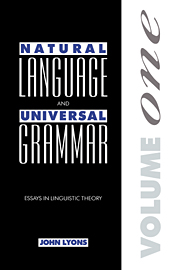Book contents
- Frontmatter
- Contents
- Preface
- Typographical conventions
- 1 Language, speech and writing
- 2 In defence of (so-called) autonomous linguistics
- 3 Linguistic theory and theoretical linguistics
- 4 Natural, non-natural and unnatural languages: English, Urdu and other abstractions
- 5 The origin of language, speech and languages
- 6 Phonemic and non-phonemic phonology: some typological reflections
- 7 Towards a ‘notional’ theory of the ‘parts of speech’
- 8 Deixis as the source of reference
- 9 Deixis and anaphora
- Appendix: The scientific study of language. Inaugural Lecture, Edinburgh, 1965
- Notes
- References
- Subject index
- Names index
8 - Deixis as the source of reference
Published online by Cambridge University Press: 05 June 2012
- Frontmatter
- Contents
- Preface
- Typographical conventions
- 1 Language, speech and writing
- 2 In defence of (so-called) autonomous linguistics
- 3 Linguistic theory and theoretical linguistics
- 4 Natural, non-natural and unnatural languages: English, Urdu and other abstractions
- 5 The origin of language, speech and languages
- 6 Phonemic and non-phonemic phonology: some typological reflections
- 7 Towards a ‘notional’ theory of the ‘parts of speech’
- 8 Deixis as the source of reference
- 9 Deixis and anaphora
- Appendix: The scientific study of language. Inaugural Lecture, Edinburgh, 1965
- Notes
- References
- Subject index
- Names index
Summary
In this paper I shall be concerned with what Quine (1960: 108) describes as the first two phases in the ontogenesis of reference. Like Quine, I shall venture no psychological details as to the actual order in which “the child of our culture” masters the “provincial apparatus of articles, copulas, and plurals” as he “scrambles up an intellectual chimney, supporting himself against each side by pressure against the others” (1960: 102, 80, 93). What I have to say about the child's acquisition of the grammar of referring expressions is not incompatible, as far as I am aware, with any of the data that has been collected and discussed in the psycholinguistic literature: but I am not claiming that all children “of our culture”, and still less children of all cultures, must go through the same stages in the acquisition of their native language and that these stages must succeed one another in a fixed order. My purpose, rather, is to show how the grammatical structure and interpretation of referring expressions (other than proper names) can be accounted for in principle on the basis of a prior understanding of the deictic function of demonstrative pronouns and adverbs in what might be loosely described as concrete or practical situations. I will argue that the definite article and the personal pronouns, in English and other languages, are (in a sense of ‘weak’ to be explained below) weak demonstratives (see Sommerstein, 1972; Thorne, 1973), and that their anaphoric use is derived from deixis.
- Type
- Chapter
- Information
- Natural Language and Universal GrammarEssays in Linguistic Theory, pp. 146 - 165Publisher: Cambridge University PressPrint publication year: 1991



